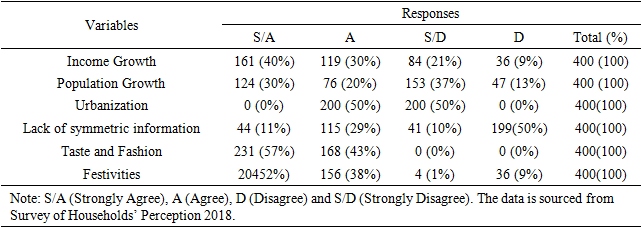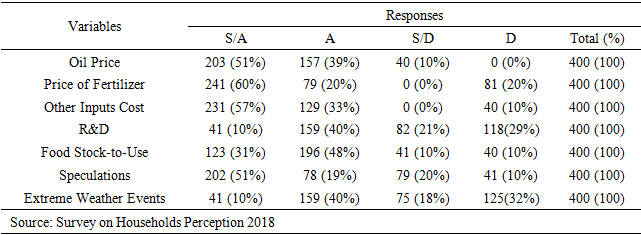-
Paper Information
- Next Paper
- Previous Paper
- Paper Submission
-
Journal Information
- About This Journal
- Editorial Board
- Current Issue
- Archive
- Author Guidelines
- Contact Us
American Journal of Economics
p-ISSN: 2166-4951 e-ISSN: 2166-496X
2020; 10(1): 37-46
doi:10.5923/j.economics.20201001.06

Food Price Dynamics and Quality of Life: A Survey of Households Perception in Sokoto State, Nigeria
Bello Utiya1, Umar Muhammad Gummi1, 2, Adamu Hassan1, Abdullahi Maria1, Aisha M. Abubakar1, 3, Lawal Bello Zoramawa1
1Department of Economics, Sokoto State University, Sokoto, Nigeria
2School of Economics and Management, Xi’an Shiyou University, Xi’an City, Shaanxi Province, P.R. China
3School of Economics, University of Nottingham, University Park, Nottingham NG7 2RD, United Kingdom
Correspondence to: Umar Muhammad Gummi, Department of Economics, Sokoto State University, Sokoto, Nigeria.
| Email: |  |
Copyright © 2020 The Author(s). Published by Scientific & Academic Publishing.
This work is licensed under the Creative Commons Attribution International License (CC BY).
http://creativecommons.org/licenses/by/4.0/

Food crisis and price fluctuation are among the major policy issues at global, regional and local food markets. This is due to their economic cost and welfare effect on individual economic agents. In this paper, we surveyed 400 households in Sokoto to ascertain their perception of the causes/determinants of food price fluctuations and how their wellbeing is affected by these fluctuations using the percentage method. On the demand side, households attached much importance to income level, festivities, and taste, while oil price, cost of fertilizer and cost of other inputs represent the key determinants on the supply side factors. Furthermore, on the exogenous factors, exchange rate, food policy, and hoarding are the main external amplifiers that drive food price in the local food markets. However, purchasing power, health, and nutritional status, and investment opportunities are the key indicators of households' quality of life that are affected by food price dynamics with an average of 82% perception rate. Our findings signalled to the fact that myriad of factors determine the behavior of food price fluctuations which affect a household's quality of life, especially for middle and low-income earners. Therefore, a holistic framework that accommodates both endogenous and exogenous factors that drive food price at both micro and macro levels becomes imperative.
Keywords: Food Price Dynamics, Quality of Life, Demand Factors, Supply Factors, Sokoto
Cite this paper: Bello Utiya, Umar Muhammad Gummi, Adamu Hassan, Abdullahi Maria, Aisha M. Abubakar, Lawal Bello Zoramawa, Food Price Dynamics and Quality of Life: A Survey of Households Perception in Sokoto State, Nigeria, American Journal of Economics, Vol. 10 No. 1, 2020, pp. 37-46. doi: 10.5923/j.economics.20201001.06.
Article Outline
1. Introduction
- Price fluctuations are not new in the global and local food markets. Episodes of price hikes and food crises were recorded in 1974, 2003/2004, 2007/2008 and 2011 (Food and Agricultural Organization-FAO, 2011). Recently, the food market witnessed another surge in prices in 2015/2016 and what distinguished it from the previous episodes is the hike in prices of not only a selected few crops but nearly all major food and feed commodities (World Food Program -WFP, 2017). Several factors are attributed to the recent price shock whose combined effect has led to an upward price movement (FAO, 2017). Firstly, cereal production fell by 3.6 per cent in 2011 and 6.9 per cent in 2012 due to unfavorable weather in major producing countries. Secondly, low stock levels to complement food consumption. Thirdly, oil prices and food prices are highly correlated (Udoh, 2012). The rapid rise in petroleum prices exerted upward pressure on food prices; as fertilizer prices nearly tripled and transport costs doubled over two years. Fourthly, increased demand from the biofuel sector (Nazlioglu, Erdem, and Soytas 2013). Lastly, economic growth in some large developing countries has led to changes in diet and increased demand for food items (Kalkuhl, Braun and Torero, 2016).Price hikes in Nigeria's food market worsened due to the poor performance of the agricultural sector occasioned by the oil boom that created serious distortions in the economy (Shitu, Akerele and Haile, 2017). The 1970-79 periods witnessed a decline in agriculture's share in the GDP from 44.6 per cent to an average of only 24 per cent. Agricultural sector's share of the GDP declined from about 31 per cent in 1973 `to about 23 per cent in 1979 and 22 per cent in 1980. Between 1981 and 1985 the percentage share fluctuated between 21 per cent and 23 per cent. The contribution of the agricultural sector to the country's GDP has continued to decline over time up to 2013 and early 2015 (African Development Bank Group- ADBG, 2015). This is merely due to over-reliance on the oil sector in financing development, the recent oil price shock in the international market exposed the economy into a recession which signaled the need to explore other sectors and diversify the economy. Between 2015 and the Q1 of 2017, the economy recorded declined and negative GDP growth rate and it is evident that poverty, hunger, unemployment, and inequality were rampant (Central Bank of Nigeria, 2018).However, efforts have been made by the previous and current administrations to revamp the agricultural sector and diversify the economy, though there is evidence of improvement in the growth rate of GDP from -2.18% in the Q1 of 2017 to 0.5% and 1.04% in the Q4 of 2017 (Central Bank of Nigeria, 2018). Consequently, demand pressures on available food supplies had risen due to the astronomic growth in population from an estimated 170 million in 2012 to over 200 million in 2017 (International Labor Organization, 2017). These have resulted in rising domestic prices and imports in recent times especially for those food items with income elastic demand. Food price volatility increases the uncertainty faced by farmers and agribusiness firms. In particular, price volatility affects a farmer's investment decisions, which has serious ramifications for the growing farm debt, farm incomes, and productivity (Aleksandrova, 2016).Extensive research efforts have been devoted to understanding the behaviour of food prices over the years. At international level, several studies concluded that higher and more volatile food prices will substantially harm the poor food consumption because food covers a significant amount of their expenditure (Ivanic and Martin, 2008; Christiaensen 2009; Piesse and Thirtle, 2009; Cohen and Garrett, 2010; Díaz-Bonilla and Ron 2010; de Hoyos and Medvedev, 2011). Also, food price fluctuations can have effects on real purchasing power and quality of life, even if they do not directly affect nominal income per se (Gilbert, 2010; Gilbert and Morgan, 2010; Compton et al. 2013; Minot, 2014; Tadesse et al. 2016; Pieters and Swinnen, 2016). In Nigeria, researchers have equally devoted their time to examine the impact of food price fluctuations on different stakeholders at national, regional and state levels, and they were able to explain the different factors (determinants) of food price fluctuations (Iheanacho and Mshelia, 2005; Agwu, 2009; Effiong and Eze, 2010; Agwu, Nwachukwu and Okoye, 2011; Shittu, Obayelu and Salman, 2015; Shitu, Akerele and Haile, 2017). However, this study contributes to the current literature by describing the causes/determinants of food price fluctuation and integrates quality of life-based on households’ perception. Previous studies tend to concentrate on macro-levels (global, regional or country) which in most cases do not give a clear explanation on the individual units that make up the group. To this end, we explore micro-level determinants of food price variability and based on descriptive statistics show how they affect households’ quality of life. Consequently, the study seeks to answer the following question; (1) what are the micro-level determinants of food price? (2) How does the price fluctuations caused by these determinants affect households quality of life? The main objective of this study is to review and describe the determinants of food price fluctuations and how these fluctuations affect households’ quality of life in Sokoto state. Our study is imperative to the domestic food and developmental policies of the government, serve as a beacon light for rational decisions of farmers and households. Accordingly, the study highlights the likely outcome of these decisions on farmers’ and households’ quality of life. The point of divergence of this study from previous studies is that it concentrates on the causes and determinants of food price dynamics in domestic markets as perceived by households and how these fluctuations alter their quality of life. Section 2 elaborates on the theoretical literature, section 3 presents the methods and procedures followed by the study to achieve its objectives, section 4 discusses the main findings, section 5 highlights the implications of findings, and section 6 presents the conclusion and proffers some suggestions.
2. Food Price Fluctuations: The Causes
- Food price fluctuation is deeply related to markets where goods and services are exchanged and where prices are formed, food market cannot be in isolation. Spatially, separated markets are linked through trade; food markets are influenced by commodity, asset, and financial markets; and these, in turn, influence trading and allocation decisions factors in the food markets (Kalkuhl et al., 2016). Because of the complex inter-linkages and interactions between several actors and economic sectors, food prices are not the mere result of farmers’ supply and consumers’ demand, and price variability is not solely determined by harvest and income shocks. Food and feed processors form part of the agricultural value-chain, as do bio-fuel refineries (Nazlioglu et al., 2013). Seeds, fertilizers, crop protection, and machinery are important inputs in the agricultural production process that increase not only productivity but may also increase financial risk because input investments have to be paid out of uncertain harvest revenues(Dercon and Christiaensen, 2011). However, governments and institutions intervene in markets by changing tariffs, imposing export restrictions or by holding stocks, and selling or buying grains (Demeke et al., 2009). Discretionary intervention can increase uncertainty and, thus, fluctuations.Agricultural prices vary because production and consumption are variable. Economists distinguish between predictable and unpredictable variability, the latter being characterized in terms of shocks. Shocks to production and consumption transmit into price variability. Production can vary either because of variations in area planted or because of yield variations, typically owing to weather (Tadesse et al., 2016). Consumption varies because of changes in incomes, changes in prices of substitutes and shifts in tastes. It is generally supposed that the most important source of price variability in agriculture is weather shocks to agricultural yields (Gilbert & Morgan, 2010). Nevertheless, demand shocks, in particular, income shocks and policy shocks, may also play an important role (Christiaensen, 2009; Gilbert, 2010). The extent to which given production and consumption shocks translate into price volatility depends on supply and demand elasticities, which, in turn, reflect the responsiveness of producers and consumers to changes in prices. It is generally agreed that these elasticities are low over the short term, in particular within the crop year (von Braun & Tadesse, 2012). Farmers cannot harvest what they have not planted and will almost invariably harvest everything that they have planted. Consumers are reluctant to revise habitual dietary patterns and, in poor countries, they may have few alternatives and become vulnerable to shocks in the market (Gilbert and Morgan, 2010).Recent studies like Tadasse et al. (2016) and Olayungbo and Hassan (2017) identified the causes of food price hikes at a macro level as biofuel demand, speculation in commodity futures markets, and macroeconomic shocks. These variables represent both the demand and the supply side of the world food equation. In an attempt to distinguish how different factors affect price changes, three groups of potential causes have been singled out by Tadesse et al (2016): exogenous shocks, also called “root” causes; “conditional” causes; and “internal” drivers (Figure 2.1). Root causes, such as extreme weather events, oil price shocks, production shocks, and demand shocks, are independent core factors affecting food price fluctuations. They are exogenous because the possibility of a causal relationship between the agricultural sector and root causes is minimal. Exogenous shocks are expected to generate food price spikes and volatility, and the magnitude of their impacts depends partly on the political and economic environment of a given country. In other words, the second group of factors related to specific political and economic conditions labeled here as conditional drivers can dampen or exacerbate exogenous shocks. Some of these factors (such as a high concentration of production or low transparency in commodity markets) are time-invariant and rather difficult to measure; they are therefore not considered in the empirical analysis. The third group of causes consists of factors that are triggered by the same price dynamics, and these internal causes are endogenous shock amplifiers (see Figure 2.1) and include discretionary trade policies, speculative activities (driven by price expectations), and declines in world food stocks (Tadesse et al., 2016).
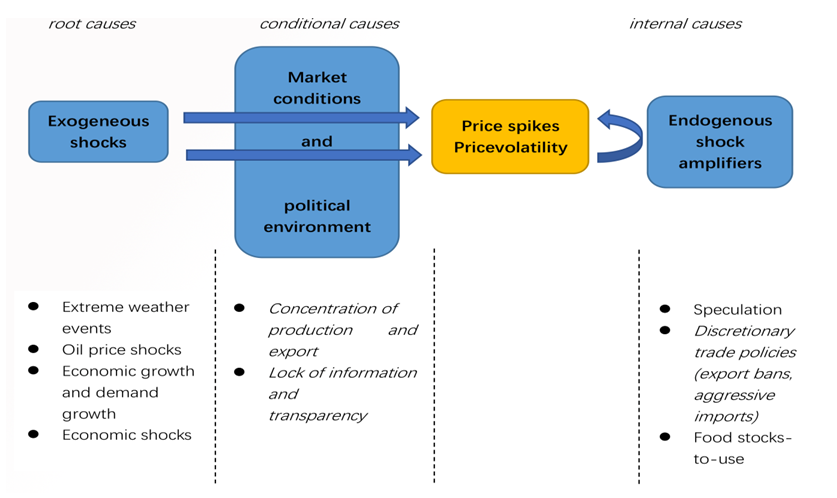 | Figure 2.1. Stylizedframeworkofthecausesofglobalfoodpricevolatilityandspikes (Source: Adopted from Tadesse et al. (2016)) |
3. Methods and Procedures
- The study employed Quantitative design and multi-stage sampling technique to select households from the 23 Local Government Areas (LGAs) in Sokoto State. Structured interview and questionnaire were administered in 2018 as instruments of data collection (see Appendix 1A) while secondary data was sourced from relevant websites and publications. Considering the scope and different stakeholders covered by this study, we used descriptive statistical analyses (percentage method) to ascertain households’ perception of food price dynamics. This was further justified by the study motive to disseminate the key findings and their implications to the right channel using visible and easily understood methods.
3.1. Brief Description of the Study Area
- Sokoto State is located in the extreme Northwest of Nigeria and has a total of twenty-three (23) LGAs. According to the census conducted by the National Bureau of Statistics in 2006, it has an estimated population of more than 4.2 million with vast land of 27,973km, square. Over 80% of people living in the state practice agriculture with an annual average temperature of 28.3°C and the rainy season are from June to October. In another survey by the NBS in 2010, Sokoto state's GDP per capita stood at $1274 billion but the poverty rate is 50.6%, the unemployment rate is 17.9%, average household size is 5.6% and population density is 133.07km2. As of 2012, the percentage of the population that is food poor is 56.5%, income inequality is measured at 0.46% and incidence of poverty stood at 81.3% in 2015. Figure 3.1 presents its geographical features and the 23 local government areas in the State.
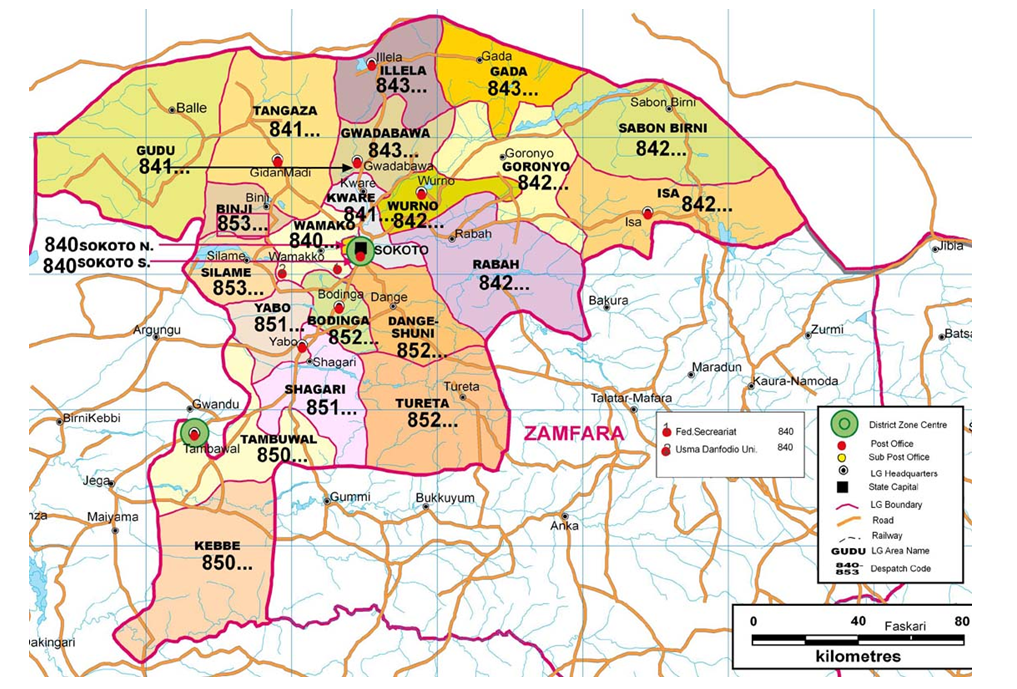 | Figure 3.1. Geographical Location of Sokoto State (Source: Sokoto State Government) |
3.2. Population and Sample
- The study examined households in Sokoto as the study population. Due to the complex nature of the population, the study draws a sample of ten (12) LGAs systematically using the expression N/n where N is the population and n is the sample size. The sample size (n) is determined using Yamane's (1998) formula for sample size determination presented in equation (2.1) with e =0.05 as the margin error.
 | (2.1) |
 | (2.2) |
3.3. Analysis
- The study utilized descriptive statistics; simple percentages and tables to present the analysis of the data surveyed from households’ perception on the causes of food price dynamics and its effect on the quality of life in Sokoto. The choice of this method is not arbitrary, rather justified by the motive of the study to disseminate the key findings to the right channel (local/rural administrators, farmers and rural households) for rational decisions and policies within the locality.
4. Discussion of Findings
- This section contains the summary and discussion of the results of the sourced data from a questionnaire administered in the field of study and is divided into four namely: demand-side factors of food price dynamics, supply-side factors, fundamental or root causes of food price dynamics and the effect of food price fluctuations on the quality of life. They are explained below-Table 4.1 shows that households' taste, festivities, and income growth are the most perceived causes of food price dynamics among the demand-side factors. 90% of the households believed that festivities (religious and traditional) caused food price dynamics in the state, while 70% of the respondents (households) believed that income growth exerted significant influence on food price fluctuations. In line with the traditional demand theory and axiom, all the households believed that taste and fashion exerts a significant effect on food price (Ojogbo and Egware, 2015). 50% of the respondents submitted to the assertion that population growth and urbanization caused food price fluctuations while only 40% believed that lack of information symmetry causes food price dynamics. These findings indicate that micro and macro demand factors followed the same trend as documented in Obayelu and Salau (2010), Tadesse et al. (2016) and Shitu et al. (2017). Thus, income growth, population dynamics, urbanization and festivities (season) converge and agree in both domestic and global food markets to be the cause of food price dynamics.
|
|
|
|
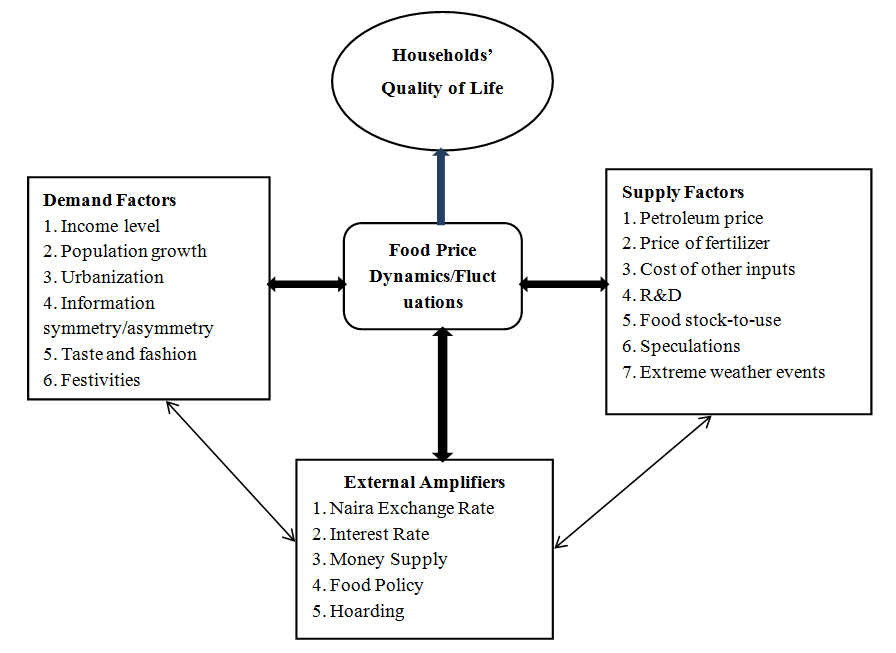 | Figure 4.1. Transmission Channels of the Causes/Determinants of Food Price Fluctuations and Households Quality of Life. (Source: Authors’ Initiative) |
5. Practical and Policy Implications
- The price hike of food commodities in Sokoto with its attendant effects on the households’ quality of life share more light on the market dynamics and food security issues. Precisely, hike in food price is caused by not only demand and supply factors but also the socioeconomic and exogenous factors. In the same vein, practical analysis of the households’ perception of food price dynamics as affected by these factors, presents a vivid explanation on the workings and operations of agricultural commodity market in Sokoto. However, the surveyed households’ perception brought new possibilities and operations in the food market. It is a long-lasting view that food price in local markets is much influenced by seasonal fluctuations with less emphasis on some key socioeconomic and exogenous factors. To this end, policies regarding food price stability and food security should cover demand factors (festivities, population growth, urbanization, symmetric information and consumers’ taste); supply factors (oil price, cost of inputs, speculation, seasonal shocks, and research and development); and exogenous shocks (especially hoarding, exchange rates and interest rates). However, based on the critical analysis of the study area, more prominence should be given to demand-side factors. This could be achieved through simultaneous adjustment of supply-side factors in order to align the two towards market equilibrium and stable prices. Furthermore, festivities account for the major cause of food price hike. Among the necessities of life, food is often regarded as the most essential for the majority of people, therefore having a responsive correlation with their quality of life. This implies that food price fluctuation caused uncertainty on household expenditure as food expenditure consumed more than 30% of average household’s income. Accordingly, the transmission mechanism makes it difficult for the households to satisfy their necessities or improve their living standard. It also reduces the quantity of calorie intake which negatively affects the health and nutritional status of the households. It is pertinent to affirm that household’s access to a variety of choices and investment opportunities have practical policy implications because they represent a significant portion of a household’s quality of life in Sokoto. Investment opportunities promote income diversification especially when there is an enabling environment for start-up businesses in the agricultural sector and other related sectors. Hopefully, this will influence farmer's investment decision, the growth and productivity in agro-business.
6. Conclusions and Recommendations
- Food price dynamics is a source of concern for the national and local economies. This study identified demand and supply factors, fundamental and exogenous factors that drive food price, and how food price fluctuation affects households' quality of life in Sokoto state. The analysis construed simple percentages on the perception of 400 households’ survey. Income growth, taste, and festivities are the major drivers of food price on the demand side, while oil price, cost of fertilizer and other inputs represent the key factors on the supply side. Majority of the household subscribed to the significant effect of macroeconomic/exogenous factors on food price fluctuations. Also, food price dynamics affect a household's quality of life in Sokoto state based on the survey of some key indicators. The study found that all the indicators measuring households' quality of life (purchasing power, investment opportunities, variety of choices, health, and nutritional status) are affected by the fluctuations in food price over time. The findings signal to the fact that a myriad of factors affects the behavior of food price and unstable price of food item affects a household's quality of life significantly. Therefore, the researchers suggest an elaborate framework that accommodates both endogenous and exogenous factors that drive food price. To maintain a high standard of living for households, food price fluctuations are among the key factors that should receive greater attention and consideration of policymakers and government of Sokoto state.
ACKNOWLEDGEMENTS
- We thank Mika’ilu Abubakar and Yusuf Umar Dantama for the helpful comments. The stimulating discussions and observations from Murtala Kaura, Abdulaziz Shehu and Nura Koko are also appreciated by the authors. All remaining errors are our own.
Data Availability and Materials
- The datasets generated and/or analyzed during the current study are not publicly available due to the nature of the study. Data on individual household about their perception of food price dynamics and how they affect their quality of life is sourced based on a survey conducted by the authors. But the survey data are available from the corresponding author on reasonable request.
Funding
- The study is funded and supported by the Tertiary Education Fund of the Federal Government of Nigeria. The study benefited from the fund through the Institutional Based Research (IBR) Grant in the 2017/2018 academic session.
Appendix
- Appendix 1A: Specimen of Questionnaire Instrument
 Dear Respondent, We seek for your kind and objective response on the questions that follow. We are currently conducting a research on the topic ‘’ Food price dynamics and quality of life: A survey of households’ perception in Sokoto, Nigeria’’. Below are the questions/corresponding statements that need your attention. Your responses will be treated with confidentiality.INSTRUCTION: Kindly provide us with an information about yourself, tick accordingly based on the options provided on each corresponding statement.PART A:BIODATA
Dear Respondent, We seek for your kind and objective response on the questions that follow. We are currently conducting a research on the topic ‘’ Food price dynamics and quality of life: A survey of households’ perception in Sokoto, Nigeria’’. Below are the questions/corresponding statements that need your attention. Your responses will be treated with confidentiality.INSTRUCTION: Kindly provide us with an information about yourself, tick accordingly based on the options provided on each corresponding statement.PART A:BIODATA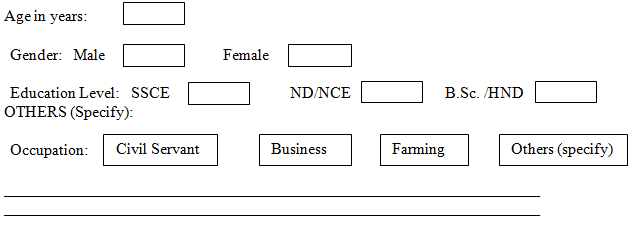 PART B:DEMAND SIDE FACTORS:
PART B:DEMAND SIDE FACTORS: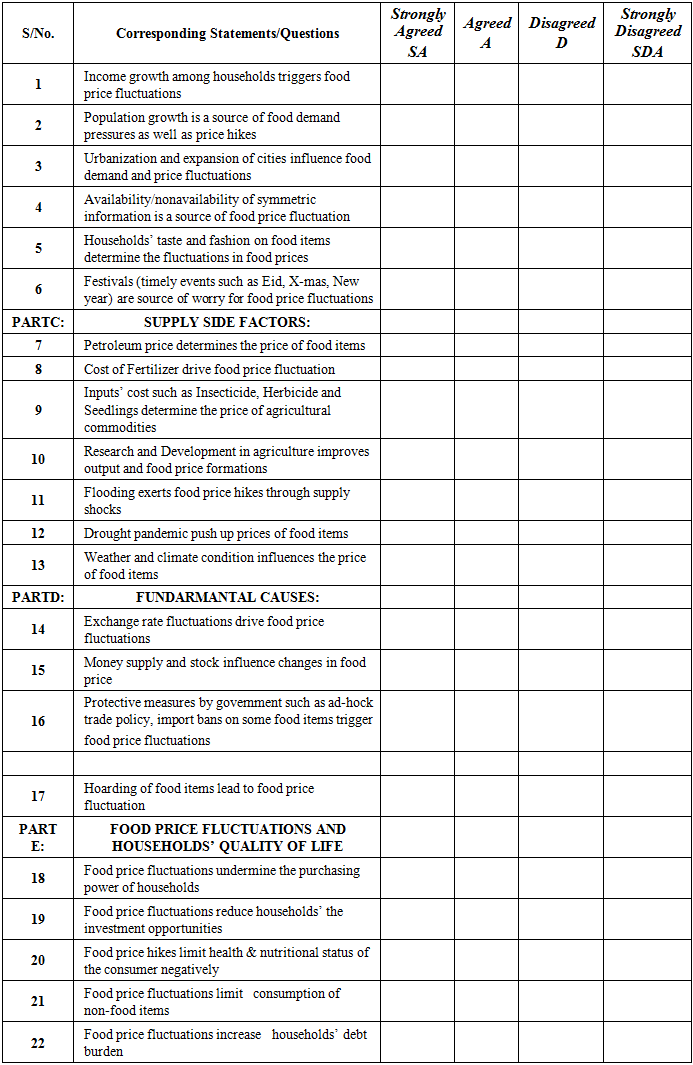
 Abstract
Abstract Reference
Reference Full-Text PDF
Full-Text PDF Full-text HTML
Full-text HTML